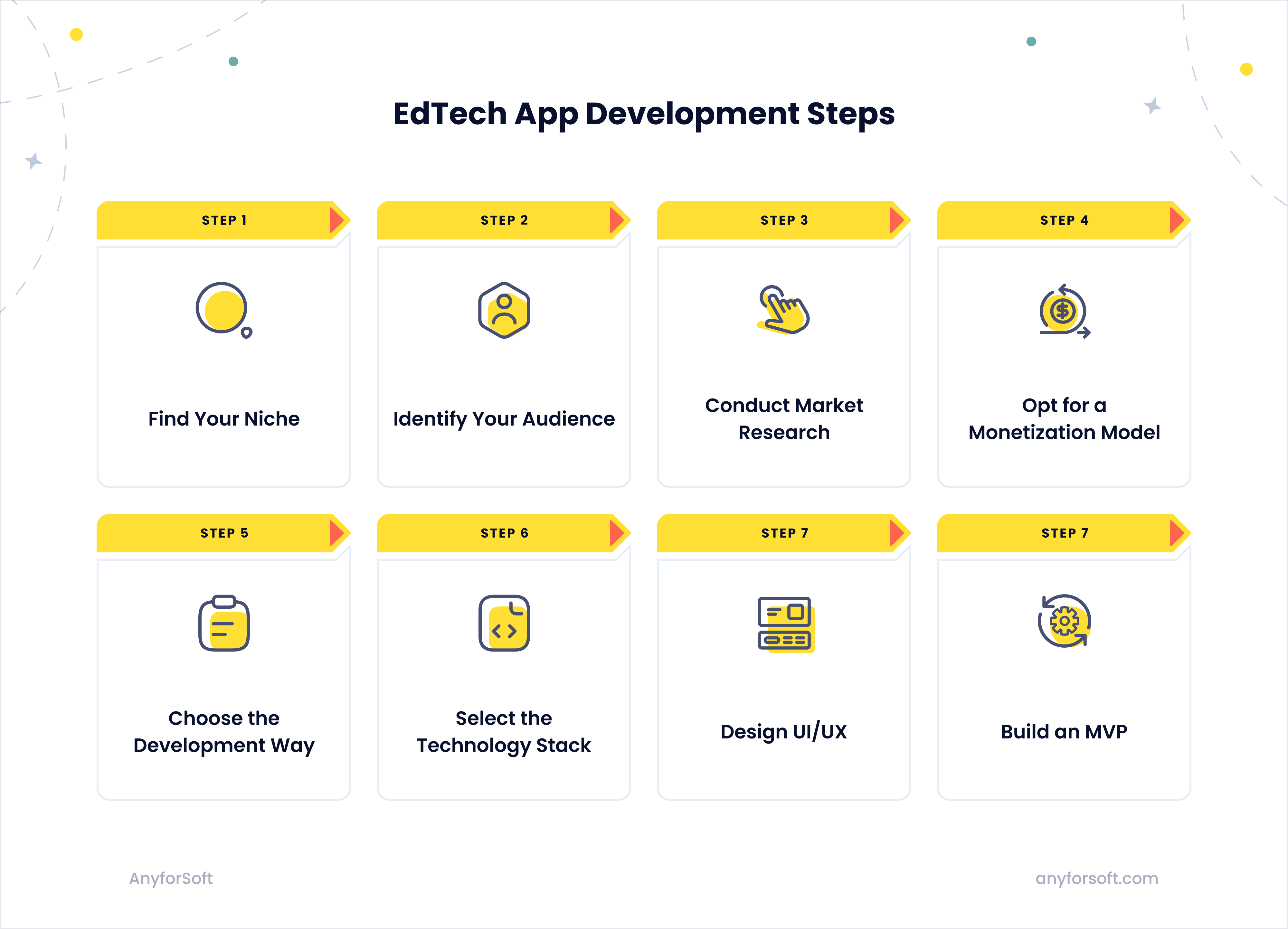The classroom of tomorrow isn’t confined to four walls and a chalkboard anymore. It’s in the palm of your hand, on your laptop screen, and maybe even in a virtual world. Today, students might dissect virtual frogs or tour ancient Rome without leaving their desks. This was made possible by the fusion of education and technology that gave rise to the educational apps.
But educational technology isn’t just about digitizing textbooks. It’s about solving real problems in education – making it not boring, effective, and accessible. Your platform could open the doors to knowledge that were once locked tight for someone. A gamified app could turn a struggling student into someone who enjoys math. Or a smart tool can help a teacher reach thirty kids at once, each learning at their own pace. At AnyforSoft, we believe that EdTech app development services are more than just coding, it’s about bringing brilliant ideas to life. So if you have one, this guide will be your first step into the future of Edtech.
Benefits of Using EdTech Platform
With the global EdTech market set to reach a staggering 810.3 million by 2033, the opportunities for innovation are boundless. North America leads the charge, but the ripple effects are felt worldwide.
So what’s the deal? Why’s everyone from a tech-savvy teenager to an old-school professor getting excited about these platforms? Let’s see what the use of EdTech apps gives to both parties of the education business.
Benefits for the EdTech app developers:
Global Reach: Your classroom can span continents. Imagine teaching a student in Tokyo while sitting in Toronto. With web and mobile apps, you’re not limited to local students – the world becomes your potential user base.
Sticky factor: Great EdTech educational apps keep users coming back for more. It’s like hitting two birds with one stone: better learning outcomes for users and a nice, steady income for you through subscriptions or in-app purchases.
Efficiency in Time and Cost: Operating digitally brings significant savings. Using educational apps with automation features like progress tracking helps online education providers reduce costs and minimize time spent on manual work.
Name recognition: Develop a platform that sets you apart, and your brand might become a recognized name in education today. The value of that visibility can’t be overstated.
Security and compliance: With modern educational apps, user data is secure, and you’re always in line with education standards.
Growth on demand: Unlike traditional schools, you can scale up quickly to meet demand without breaking the bank.
Benefits for the EdTech app users:
Learn in your PJs: Educational content is available 24/7 on your mobile devices. Study when and where it suits you.
Tailored for you: Artificial intelligence adapts to your learning style. It feels just like having a tutor who knows exactly how you learn best.
Boredom buster: Forget dry textbooks. Interactive features in educational apps make learning feel more like play.
Always fresh: EdTech platforms update regularly, ensuring you’re learning the latest and greatest in your field.
Library in your pocket: Access a world of educational resources anytime. With your smartphone, mobile learning is always within reach.
Progress tracker: For students, it’s like having a personal coach. For teachers, it’s x-ray vision into your class’s learning patterns.
Team player: Many educational apps encourage collaboration, helping you build those crucial teamwork skills.
Instant feedback: No more waiting for grades. Receive instant feedback on your progress and see where you can improve.

EdTech App Development Steps
Ready to develop an EdTech app but not sure where to start? Let’s break down the process into manageable steps that’ll take you from idea to launch.
Find Your Niche
There’s so much to learn, and even more approaches to make it happen. Hence, before you begin your educational app development, it’s vital to clarify your niche.
EdTech apps vary widely, each tailored to enhance different parts of the learning experience. Let’s break down some of the most popular categories:
- Learning Management Systems (LMS): These comprehensive online learning platforms are the backbone of many educational institutions. With Canvas and Blackboard, educators have a single platform to efficiently oversee courses, manage assignments, and keep an eye on student progress.
- Massive Open Online Courses (MOOCs): an educational technology that involves incorporating courses into the curriculum in a distance learning environment. This allows educational systems to be enriched with courses from the best universities worldwide. The most well-known MOOC platforms today are Coursera or edX.
- Subject-Specific Apps: Whether it’s Duolingo for languages or Photomath for mathematics, these apps zero in on particular subjects, offering targeted learning experiences.
- Adaptive Learning Apps: Using AI and machine learning, educational apps like Knewton adapt to each student’s pace and style, providing personalized learning paths.
- Test Preparation Apps: Whether it’s SAT prep or professional certifications, apps like Khan Academy and Magoosh help learners excel in their exams.
- Study Aid Apps: Tools like Quizlet and Anki use flashcards and spaced repetition to boost memorization and retention.
- Classroom Management Systems: As a prime example, Google Classroom improves communication between teachers and students, making it easier to organize assignments and resources.
- Gamification Apps: With EdTech applications like Kahoot!, learning becomes a fun and competitive experience, proving that education can be anything but boring.
- Special Needs Apps: With tools like Proloquo2Go, learners with speech difficulties receive crucial support, proving how EdTech drives inclusive education forward.
- AR/VR (Augmented reality/Virtual Reality) Apps: Imagine dissecting a frog without the mess. Apps like Froggipedia use augmented reality to bring textbook concepts to life.
If you already clearly know what your application will be like, you need to test your EdTech idea for viability. The first question to answer before developing an app is why and who needs it. Ask yourself: What specific problem do you want to solve and how?
And of course, since you are not creating this solution for yourself, you need to know and understand your target audience, which brings us to the next step of our educational app development process.
Identify Your Audience
The next stage of development is creating a profile of your user. We believe it’s one of the most crucial, if not the most critical, stages. Simply because this is what builds the groundwork for your product’s success. You can be proud of your brainchild as much as you like, but the target audience has the final say. What should you do to make them appreciate it the same way? The answer is simple – just create a product for your user. In fact, it is not you, but your user who decides what functions, content, and design your application will have.
So, consider who will use your app and what they hope to gain from it. And you are not just drawing a picture of your potential user in your mind. Think of it as a 360-degree view where you look at everything: job, salary, hobbies, beliefs, work.
Is your app for preschoolers? Then most likely it will be straightforward with a minimum set of functions, but with a maximum set of visual and audio content. The platform for the K-12 education system will be more comprehensive, targeting different ages and levels. Or perhaps your EdTech solutions are aimed at the Higher Education sector or senior users who simply want to develop or gain new skills. All this must be taken into account during your education app development in order not to fail to live up to expectations and not waste resources.
Conduct Market Research
Now that you know your target audience, you need to get to know your competitors and the market as a whole. Analyzing those who also offer solutions for digital education will allow you to adopt their working practices and avoid the mistakes they make. You will also be able to see the education industry gaps that your product could fill — offer your potential customers something that your competitors don’t have.
There are several nice methods for conducting competitor and market research. First, there is such a thing as SWOT analysis (analysis of strengths, weaknesses, opportunities, and threats). It’s pretty straightforward – you basically look at what your rivals are good at, where they’re messing up, what opportunities they might have, and what could trip them up.
Then we’ve got marketing strategy analysis. This is about finding out how competitors are promoting their message. We’re talking product promotion, brand positioning – the whole package.
Also, since your education app development is customer-centric, you have to get into the heads of your competitors’ customers. It is necessary to understand why they chose this or that product, and what they value it for.
Lastly, we’ve got competitive market mapping. It’s a smart way to visualize where everyone stands on this EdTech industry playground. You can spot gaps in the market, see where you stand, and keep an eye on what everyone else is up to.
Some useful tools that are commonly used at this stage include Google Trends, SurveyMonkey, Google Analytics, and of course, good old Excel spreadsheets.
Opt for a Monetization Model
One of the reasons why many startups fail is choosing an unviable business model. A business model is how your product will make money. In fact, to be honest, generating revenue is the main reason why you are creating your product. There are different ways mobile applications can generate income, and the choice depends on what you are selling and to whom.
Here are some points to consider when choosing your monetization model:
1. Who your client is:
- a business (entrepreneur, company);
- a customer (child/parent, adult);
- a government (schools, ministries, universities).
2. What your value proposition is: what user problem do you solve, what value do you deliver to the client, what package of products and/or services? These can be learning materials, online lessons with a tutor, expertise, methodology, courses, and much more.
3. How will you interact with the consumer: directly, assigning a personal manager to each client, through customer self-service, through a community, etc.?
4. How much and for what value is the client willing to actually pay and in what ways do you plan to monetize your product?
Here are the main monetization models you can play with:
- Freemium: Core features free, premium tools locked behind paywall
- Subscription tiers: Scaled access based on monthly/yearly fees
- Pay-per-course: One-time payments for specific content
- Enterprise licensing: Bulk deals for schools/organizations
- Microtransactions: Small purchases for in-app resources
- Ad-supported: Free access with targeted advertising
- Affiliate partnerships: Commissions from recommended products
- B2B SaaS model: Selling to institutions rather than end-users
- Crowdfunding: User-supported development of new features
- White-labeling: Rebranding app for other companies
These models can be mixed and matched. All you need is to find the sweet spot between user value and revenue generation. Smart EdTech players often evolve their monetization strategy as they scale.
Choose the Way to Build an Educational App
So now you know your customer, your competitors, the education market, and your place in it, and have a clear idea of what problem your app will solve and how. This means that the time has come to choose the method of education app development and those who will take on it. Here are 3 ways to build an educational app with their benefits and drawbacks:
1. App Builders are like digital toolkits. Think of them as the LEGO sets of the app world – you snap together pre-made pieces to build your app. They work well for fast projects, but you might find them limiting when trying to create something one-of-a-kind.
2. An In-House Team refers to a group of developers, designers, and other professionals employed directly by your company to work on your app project.
3. Education App Development Companies are external specialists in the EdTech field. It’s like teaming up with a bunch of tech-savvy teachers who’ve traded in their chalk for keyboards. Since they give you the best of both worlds, wonder why this isn’t a cheap option. They have plenty of expertise, but to get the best results, you’ll need to communicate your vision clearly.
When picking how to build your EdTech app, think about your wallet, your timeline, and what you really need. Tight budget and want something basic? App builders are your friends. Want full control but have time? Go for an in-house development team. Looking for a middle ground? An education app development company could be your best bet. They know mobile app development inside out, without the hassle of a full-time crew.
Select the Technology Stack
A tech stack is basically the digital toolbox you use to build an app – it’s got everything from the coding languages to the fancy frameworks that make the magic happen. These are technologies that we don’t see, but that determine how your application will work, where learning materials will be stored, how video conferencing will be carried out, and so on. The choice of a tech stack will also affect the possibility and ease of integrations, as well as scaling.
Basically, you can skip all these technical things and trust your EdTech app development company to choose the education technology stack for your app. For general information, below is a table with a set of the most effective technologies and tools used in modern EdTech apps.
Design UI/UX
The UI/UX design phase of mobile app development is not just about making your product look appealing. During this stage, the development team designs wireframes, builds prototypes, and crafts a style guide – all to ensure the user’s interaction with the app is perfect. Small details matter here. Even incompatible colors or inconvenient button placement can spoil the impression and affect the learning process of your users.
Of course, the options for good UI designs are endless, but all stylish and easy-to-use educational apps usually share the following characteristics:
- Clarity: Keep it simple. Clean layouts, easy-to-read text, and buttons that make sense. You want users to get it without scratching their heads.
- Consistency: Stick to a theme. Same colors, same fonts, same vibe throughout. It’s like your app’s personality – keep it steady.
- Feedback: Give users a little nod when they do something. A button changes color, a little animation pops up – just something to say “Yep, that worked!”
UX design focuses on the following key aspects:
- User flow: Map out how users will move through your app. You want it to feel like a smooth ride, not a maze.
- Accessibility: Make sure everyone can use your app, no matter their abilities. And it should look good whether you’re on a phone or a tablet.
- Usability testing: Get real students and teachers to try out your app. They’ll spot things you might miss and tell you what’s working (or not).
Build an MVP
The final education app development phase is the actual development, but let’s not get ahead of ourselves. Start with a minimum viable product (MVP) – it’s like a rough draft for your app.
For EdTech applications, your MVP should focus on core features that solve the main problem you’re tackling in the educational process. Maybe it’s a way to make online learning more engaging, or a tool to track student progress.
Keep it simple, but make it work well. You want to show off what your app can do, not everything it might do someday. Get feedback from real users – teachers, students, whoever your target is. They’ll tell you what’s hot and what’s not.
This approach lets you tweak your education apps before going all in. It’s cheaper, faster, and smarter than building everything at once.
In fact, the development of an MVP does not end the work on the application. You can’t just launch an EdTech app and forget about it. Over time, new educational technologies will appear, your customer base will expand, or the need to add new features will arise. All this will mean – improving, changing, scaling, reevaluating, and fixing your educational platform. And given that EdTech apps contain the personal information of students, regular security audits are a must. That is why, since E-Learning app development is a lifelong process, having a reliable EdTech app development company at your side will be an advantage.

How Much Does it Cost to Create an Educational App?
The cost of EdTech app development services varies widely, depending on several factors. Simple educational apps might start around $15,000, while complex platforms incorporating artificial intelligence and ML in education could exceed $100,000. The scope of features, target platforms, choice of development partner, and integration of advanced technologies all impact the final price tag. Whether you’re creating a basic learning tool or a sophisticated AI-driven platform, the key is to align your budget with your educational goals and target audience needs.
AnyforSoft’s EdTech App Development Experience
At AnyforSoft, we’ve been providing EdTech app development services for over a decade. We’re not just another tech company – we’re a passionate team of 90% middle and senior specialists who’ve poured our expertise into more than 150 projects. From building learning management systems that teachers actually enjoy using, to creating EdTech solutions that keep students genuinely engaged, we’ve tackled a wide range of challenges.
But we’re not here to boast; we’d rather let our work do the talking. So whether you’re a small startup or a large institution, we’re committed to turning your educational vision into reality, one line of code at a time. Our goal? To make learning more accessible, engaging, and effective through technology.








